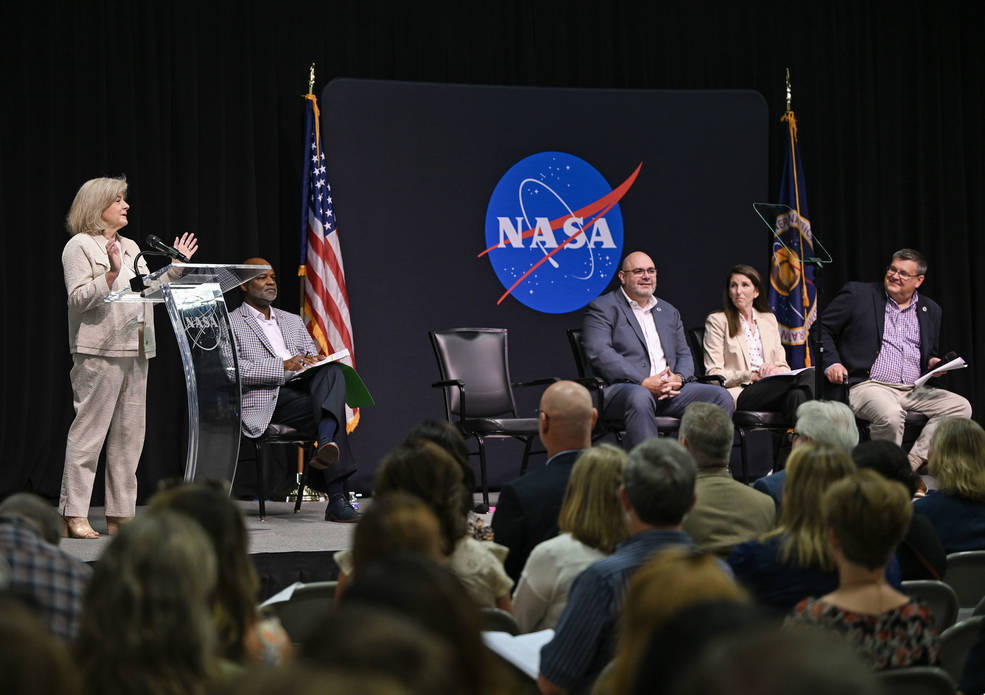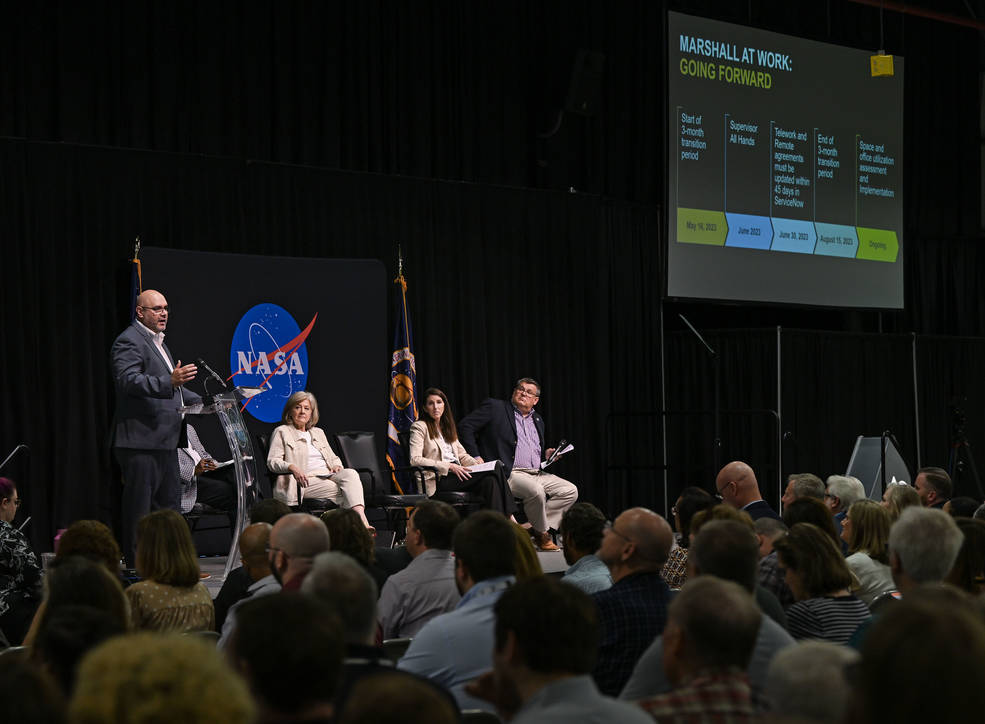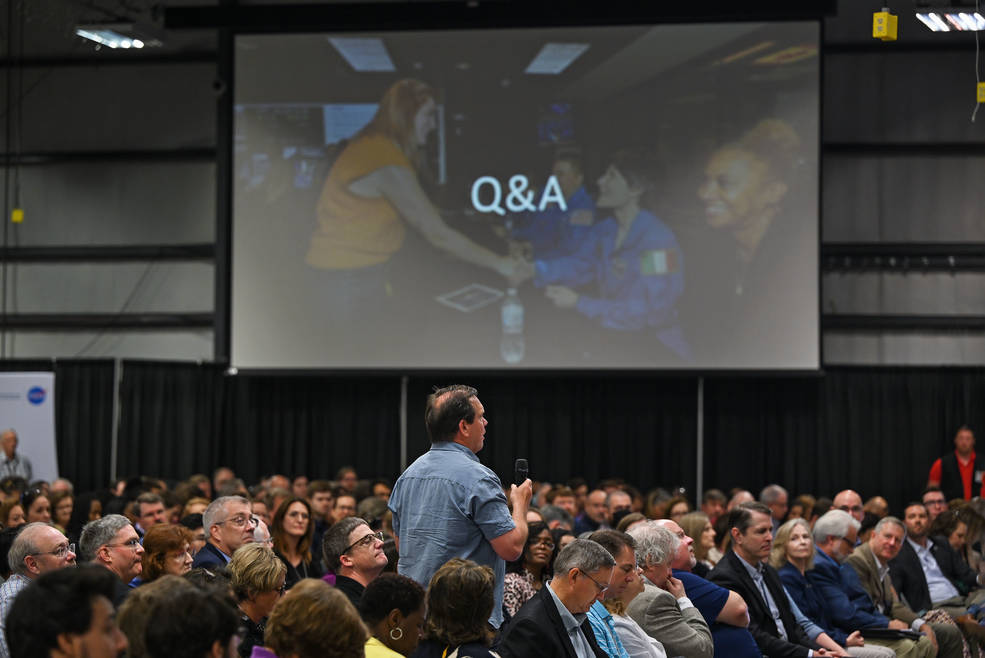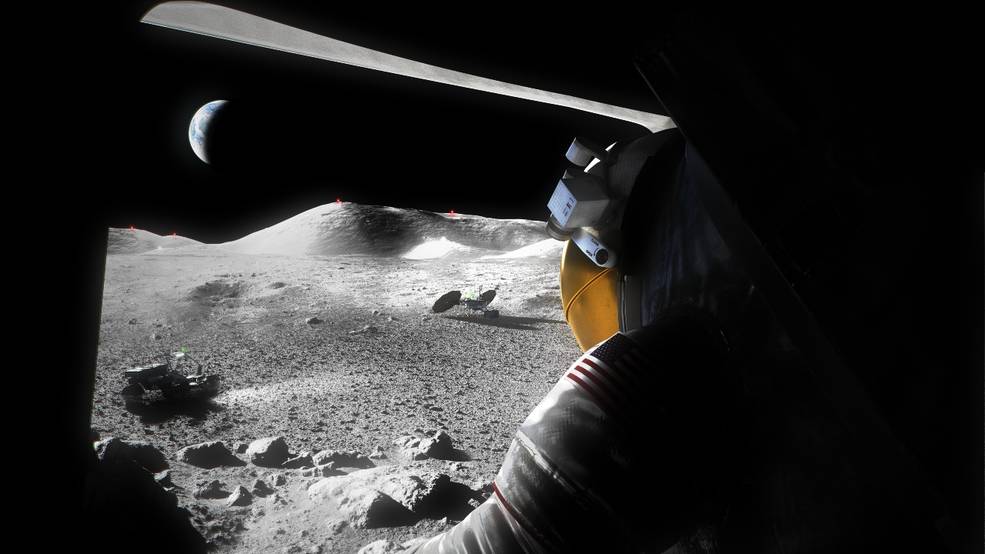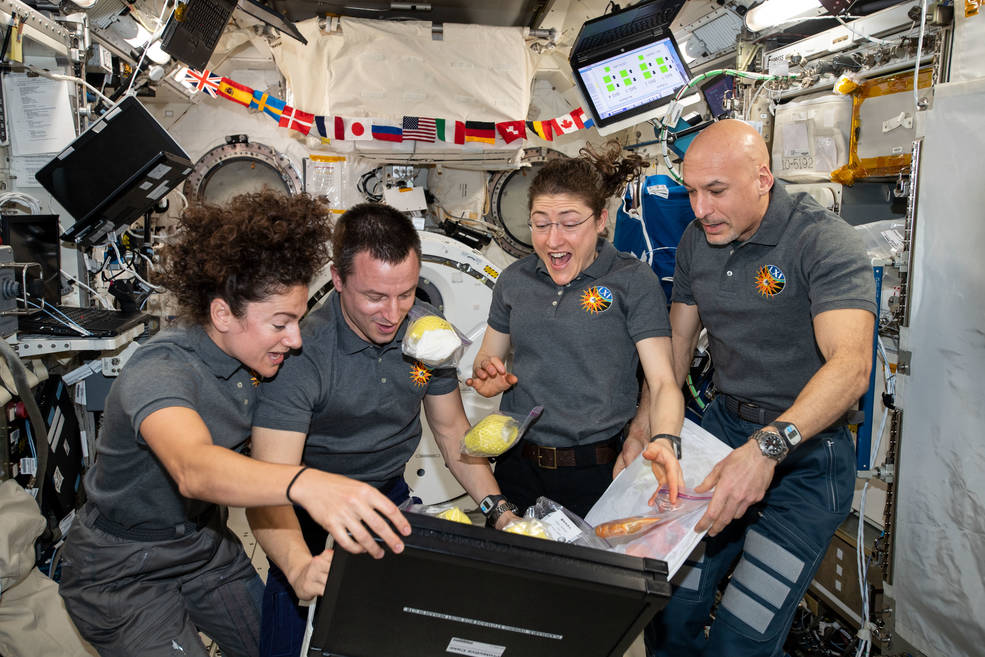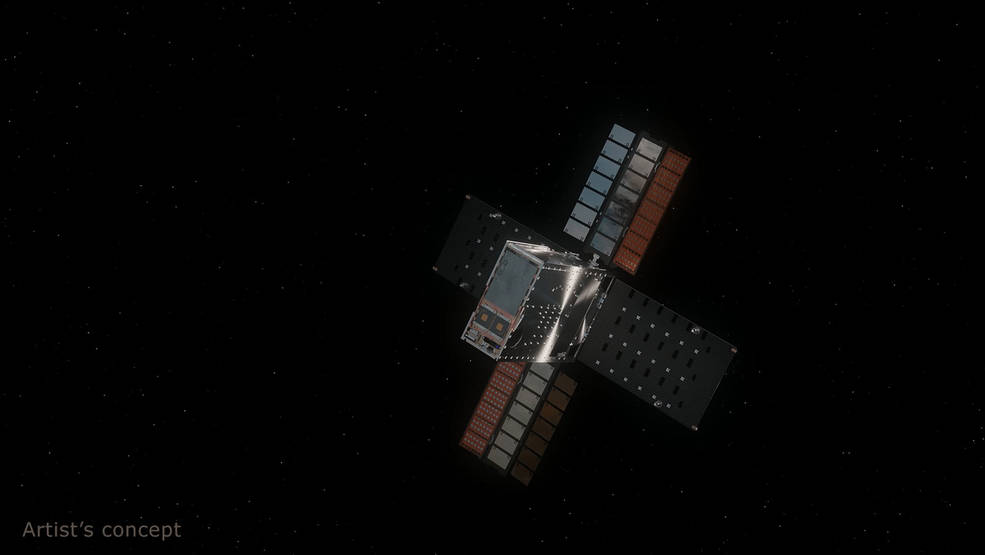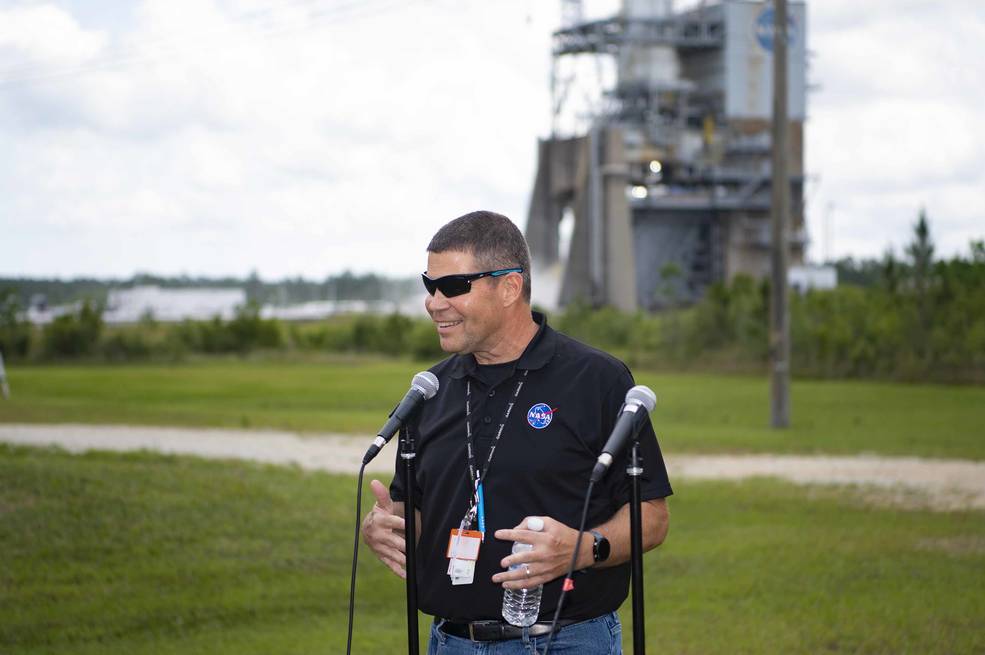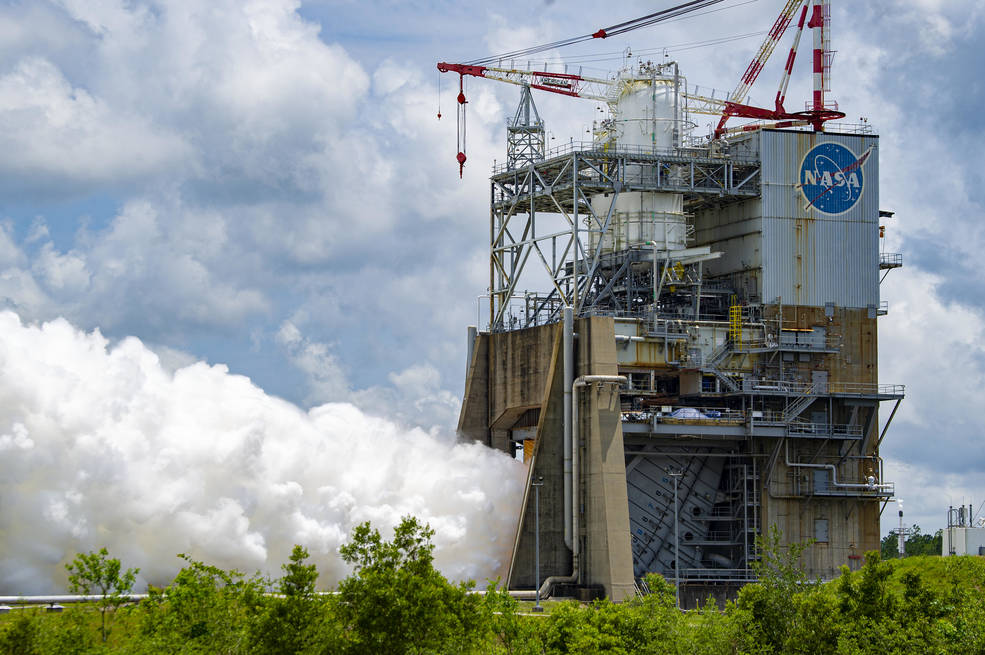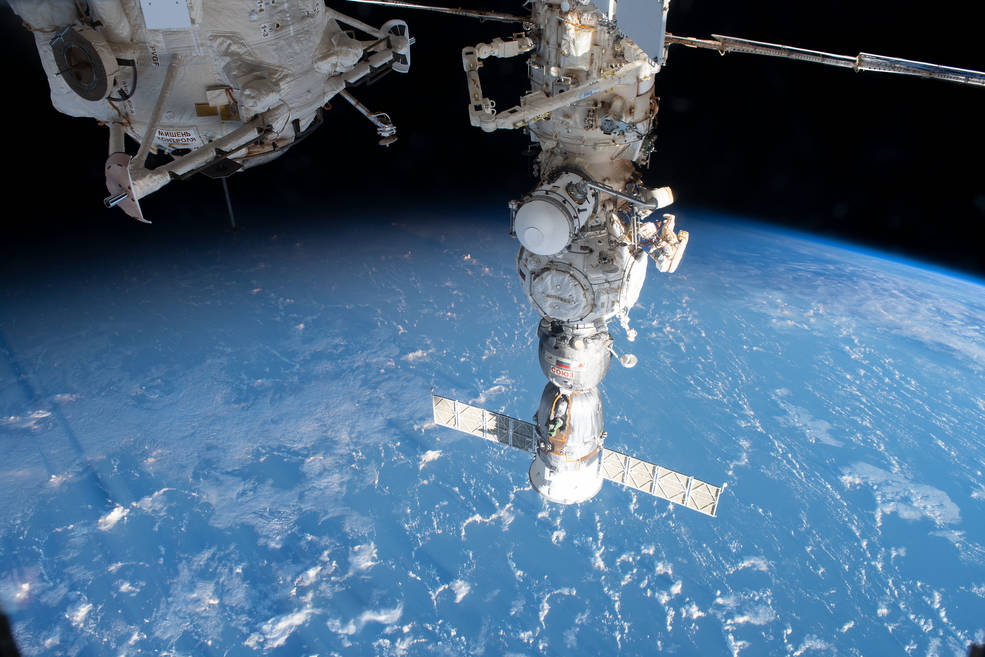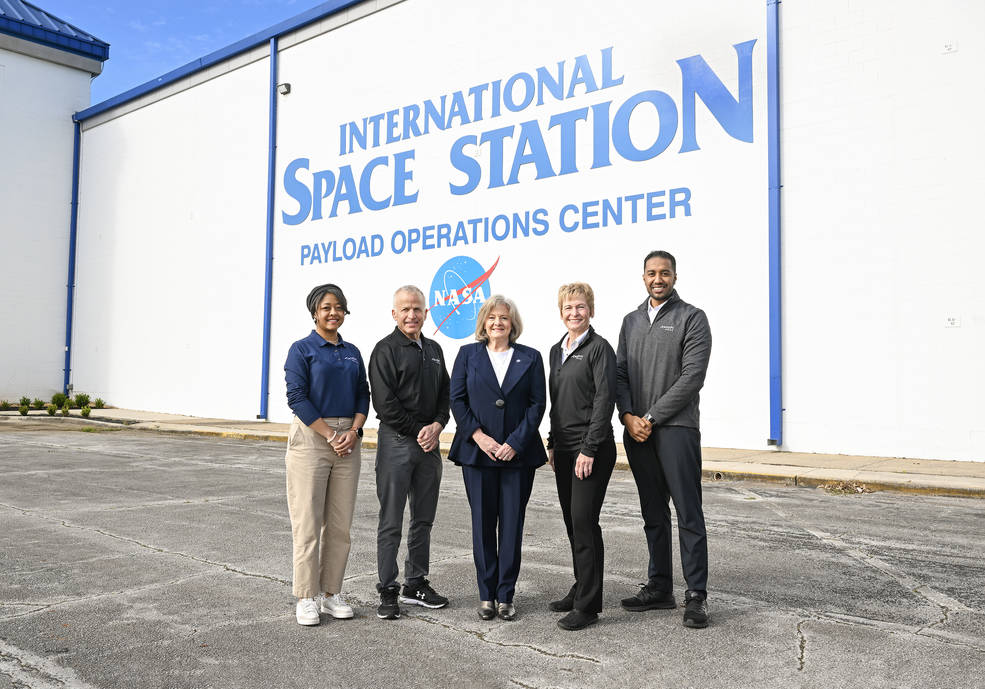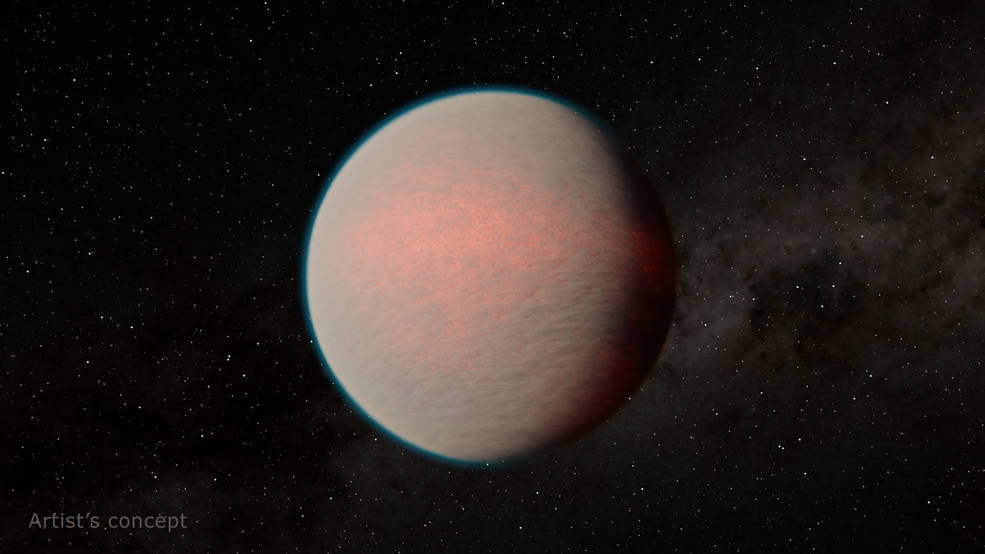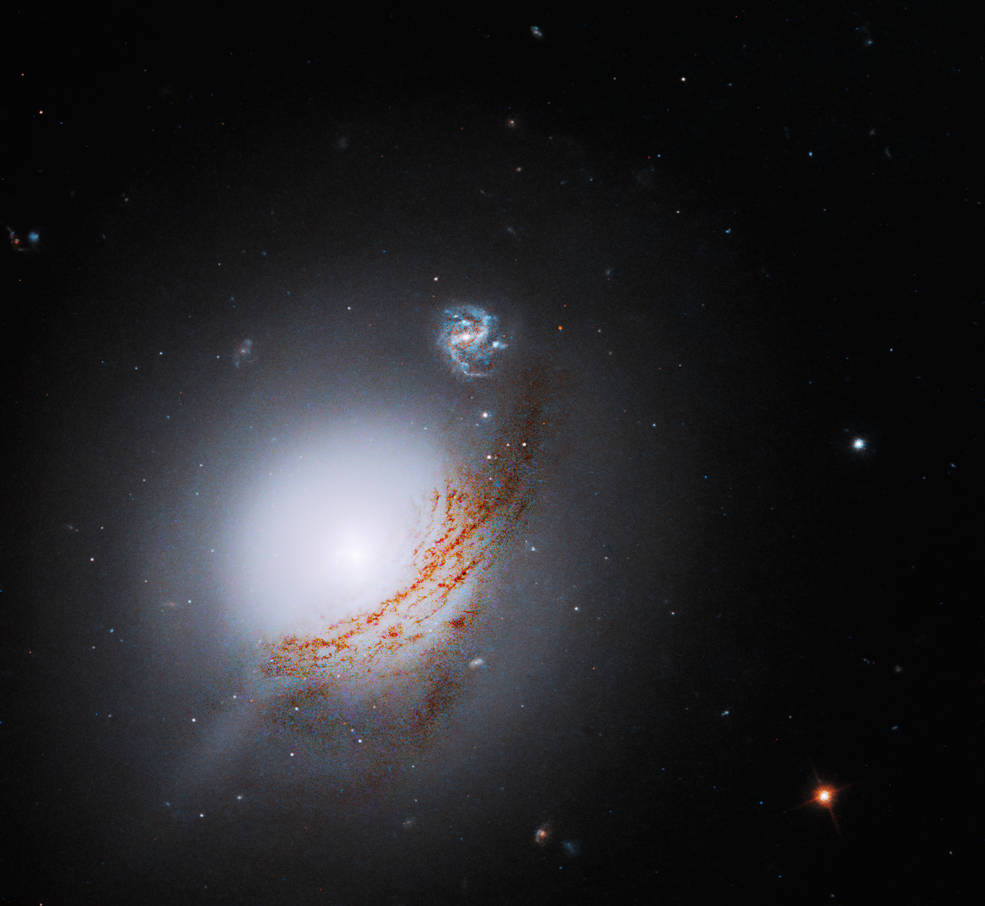The Marshall Star for May 17, 2023.
In This Week’s Star
- Marshall AT Work: Leadership Announces New Expectations for On-site Presence
- NASA to Select Second Lunar Lander Partner for Artemis Moon Mission
- Agency to Announce Second Phase Winners for Deep Space Food Challenge
- NASA Calls End to Lunar Flashlight After Some Tech Successes
- Stennis Conducts Seventh Hot-Fire Test of RS-25 Rocket Engine
- Crew Works Science, Maintenance Ahead of Second Axiom Mission
- Webb Takes Closest Look Yet at Mysterious Planet
- Hubble Views a Beautiful Luminous Galaxy
Marshall AT Work: Leadership Announces New Expectations for On-site Presence
NASA’s Marshall Space Flight Center Director Jody Singer, left, discusses upcoming changes at the center May 16 following the Biden-Harris Administration’s decision to end the COVID-19 public health emergency. The primary change is a new expectation for employees to work onsite at least three days a week, starting no later than Aug. 15. The announcement was made during an all-hands meeting held in the Activities Building (4316). “We believe three days of on-site presence enables us to have more of that dynamic interaction, that consistency, the ability to have opportunities for team building,” Singer said, adding the changes align with those of other NASA centers and organizations. Leaders also announced new and returning events, such as Bring Your Child to Work Day and Meals with Mentors; and discussed ongoing work to accommodate the expected increases in traffic, need for office space, and even food options. “It’s my goal to be the most effective center out there,” Singer said.(NASA/Charles Beason)
Marshall Deputy Director Joseph Pelfrey, left, explains how center leaders decided employees should resume working at least three days a week onsite, as well as the timeline for implementing this shift, the latter of which includes a 90-day phase-in period and a special town hall in June for supervisors. (NASA/Charles Beason)
Marshall team members asked senior leadership about competitive pay, gate traffic, employee retention and recruiting efforts, and more during the Q&A portion of the May 16 all-hands meeting. (NASA/Charles Beason)
NASA to Select Second Lunar Lander Partner for Artemis Moon Mission
NASA will announce the company selected to develop a sustainable human landing system for the Artemis V Moon mission May 19, 9:30 a.m. CDT, during an event at the agency’s headquarters in Washington. The human landing system will take astronauts to and from Gateway in lunar orbit to the surface and back to the lunar space station as part of NASA’s return to the Moon for science, exploration, and inspiration.
The announcement will air on NASA Television, the NASA app, and the agency’s website.
NASA participants will include:
- NASA Administrator Bill Nelson
- Jim Free, associate administrator, Exploration Systems Development Mission Directorate, NASA Headquarters
- Lisa Watson-Morgan, manager, Human Landing System Program, NASA’s Marshall Space Flight Center.
NASA is partnering with industry providers to develop, build, test, and launch innovative and technically advanced landers for the Artemis Generation. The second selected company will design, develop, test, and evaluate a human landing system under the Next-STEP Appendix P broad agency announcement for sustaining lunar development. The agency is already working with SpaceX to develop landers for the Artemis III and Artemis IV missions.
With Artemis, NASA will land the first woman and first person of color on the lunar surface and establish long-term exploration for scientific discovery and to prepare for human missions to Mars. The agency’s Space Launch System rocket and NASA’s Orion spacecraft, along with the human landing system, next-generation spacesuits, and the lunar spaceship Gateway, are NASA’s foundation for deep space exploration.
Agency to Announce Second Phase Winners for Deep Space Food Challenge
NASA will announce the second phase winners of its Deep Space Food Challenge, a global competition to help develop innovative food systems for future spacefarers on long-term exploration missions, on May 19.
Teams will showcase their ideas during the NYCxDESIGN Festival in New York, a citywide celebration of design.
NASA will reveal the winning Phase 2 teams. The awards event will stream live online beginning at 11 a.m. CDT from the Smart Design studio, Building 127, at the Brooklyn Navy Yard.
On May 20, teams taking part in the challenge will showcase some of their food production technologies beginning at 11 a.m. The event is free and open to the public through 4 p.m. Members of the public interested in attending must reserve a spot.
From 4 p.m. to 5:30 p.m., NASA speakers will take part in a panel discussion hosted by Smart Design and focused on design, innovation, and the future of food.
The Deep Space Food Challenge calls solvers around the world to invent new ways of producing food for future astronauts traveling farther from Earth than ever before. Since January 2021, teams have been designing and building new food tech solutions that would help keep astronauts safe, healthy, and productive for missions lasting years at a time.
The competition is a first-of-its-kind collaboration between NASA and CSA (Canadian Space Agency). On April 27, CSA awarded prizes to the teams advancing to the final stage of the Canadian challenge, which runs in parallel with NASA’s.
The not-for-profit Methuselah Foundation administers the competition for U.S. and international teams through a Space Act Agreement with NASA. The Deep Space Food Challenge is part of NASA’s Prizes, Challenges, and Crowdsourcing program in the agency’s Space Technology Mission Directorate.
Visit here for more information on the challenge.
NASA Calls End to Lunar Flashlight After Some Tech Successes
NASA’s Lunar Flashlight launched on Dec. 11, 2022, to demonstrate several new technologies, with an ultimate goal to seek out surface ice in the permanently shadowed craters of the Moon’s South Pole. Since then, the briefcase-size satellite’s miniaturized propulsion system – the first of its kind ever flown – proved unable to generate enough thrust to get into lunar orbit, despite months of effort by the operations team. Because the CubeSat cannot complete maneuvers to stay in the Earth-Moon system, NASA has called an end to the mission.
NASA relies on technology demonstrations to fill specific knowledge gaps and to test new technologies. Used for the first time beyond Earth’s orbit, Lunar Flashlight’s propulsion system and green fuel were such demonstrations. Although the propulsion system was unable to produce the desired thrust – likely because of debris buildup in the thruster fuel lines – newly developed propulsion system components exceeded performance expectations.
Also surpassing expectations were Lunar Flashlight’s never-before-flown Sphinx flight computer – a low-power computer developed by NASA’s Jet Propulsion Laboratory to withstand the radiation of deep space – and the spacecraft’s upgraded Iris radio. Featuring a new precision navigation capability, the radio can be used by future small spacecraft to rendezvous and land on solar system bodies.
“Technology demonstrations are, by their nature, higher risk and high reward, and they’re essential for NASA to test and learn,” said Christopher Baker, program executive for Small Spacecraft Technology in the Space Technology Mission Directorate at NASA Headquarters. “Lunar Flashlight was highly successful from the standpoint of being a testbed for new systems that had never flown in space before. Those systems, and the lessons Lunar Flashlight taught us, will be used for future missions.”
The mission’s miniaturized four-laser reflectometer, a science instrument that had never flown before, either, also tested successfully, giving the mission’s science team confidence that the laser would have been able to detect ice if it were present at the lunar surface.
“It’s disappointing for the science team, and for the whole Lunar Flashlight team, that we won’t be able to use our laser reflectometer to make measurements at the Moon,” said Barbara Cohen, the mission’s principal investigator at NASA’s Goddard Space Flight Center. “But like all the other systems, we collected a lot of in-flight performance data on the instrument that will be incredibly valuable to future iterations of this technique.”
Despite the mission’s technological wins, Lunar Flashlight’s miniaturized propulsion system struggled to provide sufficient thrust to put the CubeSat on course for the planned near-rectilinear halo orbit that would have given the spacecraft weekly flybys of the Moon’s South Pole.
The team suspects that debris obstructed the fuel lines, causing the diminished and inconsistent thrust. The miniaturized propulsion system included an additively manufactured fuel feed system that likely developed the debris – such as metal powder or shavings – and obstructed fuel flow to the thrusters, limiting their performance. Although the team devised a creative method for using just one thruster to maneuver the spacecraft, Lunar Flashlight needed more consistent thrust to reach its planned orbit.
The operations team calculated a new orbit that could be reached using the spacecraft’s small amount of potential remaining thrust. The plan called for putting the CubeSat on a path that would place it in orbit around Earth rather than the Moon, with monthly flybys of the lunar South Pole. While this would have meant fewer flybys, the spacecraft would have flown closer to the surface.
With the mission running out of time to arrive at the needed orbit, the operations team tried to dislodge any debris from the fuel lines by increasing the fuel pressure well beyond the propulsion system’s designed capacity. Despite limited success, the required trajectory correction maneuvers couldn’t be completed in time.
“The student operations team at Georgia Tech, with assistance from JPL and NASA’s Marshall Space Flight Center, rose to the challenge and came up with an incredible array of inventive techniques to utilize what tiny amount of thrust Lunar Flashlight’s propulsion system could deliver,” said John Baker, Lunar Flashlight project manager at JPL. “We learned a lot and honed new methods and strategies for working with tiny spacecraft.”
After having traveled out past the Moon, Lunar Flashlight is now moving back toward Earth and will fly past our planet with a close approach of about 40,000 miles on May 17. The CubeSat will then continue into deep space and orbit the Sun. It continues to communicate with mission operators, and NASA is weighing options for the future of the spacecraft.
Lunar Flashlight is managed for NASA by JPL, a division of Caltech in Pasadena, California. The CubeSat is operated by Georgia Tech, including graduate and undergraduate students. The Lunar Flashlight science team is led by NASA Goddard and includes team members from the University of California, Los Angeles; Johns Hopkins University Applied Physics Laboratory; and the University of Colorado.
The CubeSat’s propulsion system was developed by Marshall, with development and integration support from Georgia Tech. NASA’s Small Business Innovation Research program funded component development from small businesses including Plasma Processes Inc. (Rubicon) for thruster development, Flight Works for pump development, and Beehive Industries (formerly Volunteer Aerospace) for specific 3D-printed components. The Air Force Research Laboratory also contributed financially to the development of Lunar Flashlight’s propulsion system. Lunar Flashlight is funded by the Small Spacecraft Technology program based at NASA’s Ames Research Center and within NASA’s Space Technology Mission Directorate.
Read more about the Lunar Flashlight mission here.
Stennis Conducts Seventh Hot-Fire Test of RS-25 Rocket Engine
SLS (Space Launch System) Chief Engineer John Blevins joined NASA’s Stennis Space Center team May 10 for an RS-25 certification engine hot-fire test in support of engine production for future SLS flights and Artemis missions. During the test, the engine fired for more than 10 minutes (630 seconds), which is longer than the 500 seconds the engines must fire to help launch the SLS rocket to orbit. NASA’s Marshall Space Flight Center manages the SLS Program. (NASA)
An Aerojet Rocketdyne RS-25 rocket engine is tested on the Fred Haise Test Stand at Stennis on May 10. This was the seventh hot-fire test in a planned 12-test series of the newly redesigned RS-25 engines that will be used beginning with Artemis V. (NASA)
Crew Works Science, Maintenance Ahead of Second Axiom Mission
Mission managers have given the go for the launch of the second private astronaut mission to the International Space Station on May 21. The Expedition 69 crew is preparing to meet the new astronauts while also keeping up its human research, maintaining orbital lab systems, and stowing spacewalk tools.
Axiom Space, SpaceX, and NASA managers met on May 15 and agreed to launch four Axiom Mission-2 (Ax-2) crew members to the space station at 4:37 p.m. CDT on May 21. Veteran astronaut and commander Peggy Whitson will lead first-time space flyers pilot John Shoffner and mission specialists Ali Alqarni and Rayyanah Barnawi aboard the SpaceX Dragon spacecraft and guide it to an automated docking at 9:24 a.m. on May 22. The private astronauts will enter the station through the Harmony module’s space-facing port and begin several days of research, outreach, and commercial activities before returning to Earth.
Four station flight engineers joined each other May 16 and reviewed the Ax -2 mission schedule. NASA astronauts Stephen Bowen, Frank Rubio, and Woody Hoburg, along with United Arab Emirates astronaut Sultan Alneyadi familiarized themselves with the upcoming mission activities and reviewed how the crews will coordinate during docked operations.
In the meantime, the seven space station residents continued ongoing microgravity science and kept up the maintenance of the orbital outpost. Spacesuit work and cargo transfers also rounded out the day.
Bowen was back on human research May 16 servicing samples in a centrifuge for a study exploring the immunity systems of astronauts. Rubio powered on the Astrobee free-flying robotic assistants then removed experiment hardware from inside the Kibo laboratory module’s airlock.
Hoburg and Alneyadi spent most of the day working on the Tranquility module’s treadmill. The duo rotated the exercise rack from its stowage position to gain access to its internal electronics components for inspection and cleaning. Alneyadi then spent a few moments testing the operations of the Astrobees for an upcoming student competition to control the robotic devices.
Commander Sergey Prokopyev and flight engineer Dmitri Petelin continued cleaning up after last week’s spacewalk. The duo reconfigured the Poisk airlock and stowed the tools and hardware used during the five-hour and 14-minute excursion that saw the deployment of a radiator on the Nauka science module. Prokopyev also partnered with Roscosmos flight engineer Andrey Fedyaev unpacking cargo from the ISS Progress 83 cargo craft, while Petelin also explored how weightlessness affects the cardiovascular system.
Earlier this year, the Human Exploration Development & Operations Office at NASA’s Marshall Space Flight Center hosted a training event for the Ax-2 astronauts March 16-17 at the Huntsville Operations Support Center inside the Payload Operations Integration Center. The training offered the crew members an understanding of NASA payload operations integration and crew interfaces, exposure to Marshall’s facilities and capabilities, and opportunities to build relationships with payload operations integration team members during the preflight timeframe.
Private astronaut missions to the space station are a precursor to privately funded commercial space stations as part of NASA’s efforts to develop a thriving low-Earth orbit ecosystem and marketplace.
Learn more about the space station at this blog.
Webb Takes Closest Look Yet at Mysterious Planet
NASA’s James Webb Space Telescope has observed a distant planet outside our solar system – and unlike anything in it – to reveal what is likely a highly reflective world with a steamy atmosphere. It’s the closest look yet at the mysterious world, a “mini-Neptune” that was largely impenetrable to previous observations.
And while the planet, called GJ 1214 b, is too hot to harbor liquid-water oceans, water in vaporized form still could be a major part of its atmosphere.
“The planet is totally blanketed by some sort of haze or cloud layer,” said Eliza Kempton, a researcher at the University of Maryland and lead author of a new paper, published in Nature, on the planet. “The atmosphere just remained totally hidden from us until this observation.” She noted that, if indeed water-rich, the planet could have been a “water world,” with large amounts of watery and icy material at the time of its formation.
To penetrate such a thick barrier, the research team took a chance on a novel approach: In addition to making the standard observation – capturing the host star’s light that has filtered through the planet’s atmosphere – they tracked GJ 1214 b through nearly its entire orbit around the star.
The observation demonstrates the power of Webb’s Mid-Infrared Instrument (MIRI), which views wavelengths of light outside the part of the electromagnetic spectrum that human eyes can see. Using MIRI, the research team was able to create a kind of “heat map” of the planet as it orbited the star. The heat map revealed – just before the planet’s orbit carried it behind the star, and as it emerged on the other side – both its day and night sides, unveiling details of the atmosphere’s composition.
“The ability to get a full orbit was really critical to understand how the planet distributes heat from the day side to the night side,” Kempton said. “There’s a lot of contrast between day and night. The night side is colder than the day side.” In fact, the temperatures shifted from 535 to 326 degrees Fahrenheit (from 279 to 165 degrees Celsius).
Such a big shift is only possible in an atmosphere made up of heavier molecules, such as water or methane, which appear similar when observed by MIRI. That means the atmosphere of GJ 1214 b is not composed mainly of lighter hydrogen molecules, Kempton said, which is a potentially important clue to the planet’s history and formation – and perhaps its watery start.
“This is not a primordial atmosphere,” she said. “It does not reflect the composition of the host star it formed around. Instead, it either lost a lot of hydrogen, if it started with a hydrogen-rich atmosphere, or it was formed from heavier elements to begin with – more icy, water-rich material.”
And while the planet is hot by human standards, it is much cooler than expected, Kempton noted. That’s because its unusually shiny atmosphere, which came as a surprise to the researchers, reflects a large fraction of the light from its parent star rather than absorbing it and growing hotter.
The new observations could open the door to deeper knowledge of a planet type shrouded in uncertainty. Mini-Neptunes – or sub-Neptunes as they’re called in the paper – are the most common type of planet in the galaxy, but mysterious to us because they don’t occur in our solar system. Measurements so far show they are broadly similar to, say, a downsized version of our own Neptune. Beyond that, little is known.
“For the last almost decade, the only thing we really knew about this planet was that the atmosphere was cloudy or hazy,” said Rob Zellem, an exoplanet researcher who works with co-author and fellow exoplanet researcher Tiffany Kataria at NASA’s Jet Propulsion Laboratory in Southern California. “This paper has really cool implications for additional detailed climate interpretations – to look at the detailed physics happening inside this planet’s atmosphere.”
The new work suggests the planet might have formed farther from its star, a type known as a red dwarf, then spiraled gradually inward to its present, close orbit. The planet’s year – one orbit around the star – takes only 1.6 Earth days.
“The simplest explanation, if you find a very water-rich planet, is that it formed farther away from the host star,” Kempton said.
Further observations will be needed to pin down more details about GJ 1214 b as well as the formation histories of other planets in the mini-Neptune class. While a watery atmosphere seems likely for this planet, a significant methane component also is possible. And drawing broader conclusions about how mini-Neptunes form will require more of them to be observed in depth.
“By observing a whole population of objects like this, hopefully we can build up a consistent story,” Kempton said.
The James Webb Space Telescope is the world’s premier space science observatory. Webb will solve mysteries in our solar system, look beyond to distant worlds around other stars, and probe the mysterious structures and origins of our universe and our place in it. Webb is an international program led by NASA with its partners, ESA (European Space Agency), and CSA (Canadian Space Agency).
MIRI was developed through a 50-50 partnership between NASA and ESA. NASA’s Jet Propulsion Laboratory led the U.S. efforts for MIRI, and a multinational consortium of European astronomical institutes contributes for ESA. George Rieke with the University of Arizona is the MIRI science team lead. Gillian Wright is the MIRI European principal investigator. Alistair Glasse with UK ATC is the MIRI instrument scientist, and Michael Ressler is the U.S. project scientist at JPL. Laszlo Tamas with UK ATC manages the European Consortium. The MIRI cryocooler development was led and managed by JPL, in collaboration with Northrop Grumman in Redondo Beach, California, and NASA’s Goddard Space Flight Center. Caltech manages JPL for NASA.
Learn more about the Webb mission.
Hubble Views a Beautiful Luminous Galaxy
The lenticular galaxy NGC 5283 is the subject of this NASA Hubble Space Telescope image. NGC 5283 contains an active galactic nucleus, or AGN. An AGN is an extremely bright region at the heart of a galaxy where a supermassive black hole exists. When dust and gas fall into the black hole, the matter heats up and emits light across the electromagnetic spectrum. NGC 5283 is a Seyfert galaxy. About 10% of all galaxies are Seyfert galaxies, and they differ from other galaxies that contain AGNs because the galaxy itself is clearly visible. Other AGNs emit so much radiation that they outshine or make it impossible to observe the structure of their host galaxy. Hubble observed this galaxy as part of a survey for a dataset about nearby AGNs, which will serve as a resource for astronomers investigating AGN physics, black holes, host galaxy structure, and more. (Image Credit: NASA, ESA, A. Barth (University of California – Irvine), and M. Revalski (STScI); Processing: Gladys Kober (NASA/Catholic University of America)


























